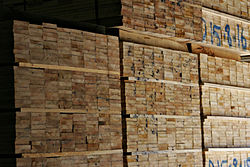A forest product is any material derived from a forestry for direct consumption or commercial use, such as lumber, paper or forage for livestock. Wood, by far the dominant forest product used for many purposes, such as wood fuel (e.g. in form of firewood or charcoal) or the finished structural materials used for the construction of buildings, or as a raw material, in the form of wood pulp, that is used in the production of paper. All other non-wood products derived from forest resources, comprising a broad variety of other forest products, are collectively described as non-timber forest products.
Resources Pressures
Many forest management policies have been implemented that impact forest product economics including forest access restrictions, harvesting fees, and harvest limits. Deforestation, global warming and other environmental concerns have increasingly affected the availability and sustainability of forest products, as well as the economies of regions dependent upon forestry around the world. In recent years, the idea of sustainable forestry, which aims to preserve crop yields without causing irreversible damage to ecosystem health, has changed the relationship between environmentalists and the forest products industry. Stakeholders in the forest products industry include government departments, commercial enterprises, non-governmental organizations (NGOs), policy-makers and analysts, private and international organizations.

Forest Products Details
Resources Pressures
Many forest management policies have been implemented that impact forest product economics including forest access restrictions, harvesting fees, and harvest limits. Deforestation, global warming and other environmental concerns have increasingly affected the availability and sustainability of forest products, as well as the economies of regions dependent upon forestry around the world. In recent years, the idea of sustainable forestry, which aims to preserve crop yields without causing irreversible damage to ecosystem health, has changed the relationship between environmentalists and the forest products industry. Stakeholders in the forest products industry include government departments, commercial enterprises, non-governmental organizations (NGOs), policy-makers and analysts, private and international organizations.

Wood cut from Victorian Mountain Ash
Forest Products Details
Since 1947, the Food and Agriculture Organization of the United Nations has published an annual yearbook of forest products. The FAO Yearbook of Forest Products is a compilation of statistical data on basic forest products for all countries and territories of the world. It contains series of annual data on the volume of production and the volume and value of trade in forest products. It includes tables showing direction of trade and average unit values of trade for certain products. Statistical information in the yearbook is based primarily on data provided to the FAO Forestry Department by the countries through questionnaires or official publications. In the absence of official data, FAO makes an estimate based on the best information available.
FAO also publishes an annual survey of pulp and paper production capacities around the world. The survey presents statistics on pulp and paper capacity and production by country and by grade. The statistics are based on information submitted by correspondents worldwide, most of them pulp and paper associations, and represents 85% of the world production of paper and paperboard.
References- "FAO Yearbook of Forest Products 2012",(PDF). http://www.fao.org/forestry/statistics/80570/en/, FAO. Retrieved 31 July 2014. External link in
|website=(help). - ^ "Pulp and paper capacity survey 2013-2018",(PDF). http://www.fao.org/forestry/statistics/81757/en/, FAO. Retrieved 31 July 2014. External link in
|website=(help).
- Harry Nichols Whitford (1920). "Tropical Forest Products" Encyclopedia Americana.
- Forests Products data in Canada since 1990
- Wikipedia





No comments:
Post a Comment